Power Lust Death:He Wenjue
权力、情欲、死亡——何汶玦艺术创作体系的延续与深化
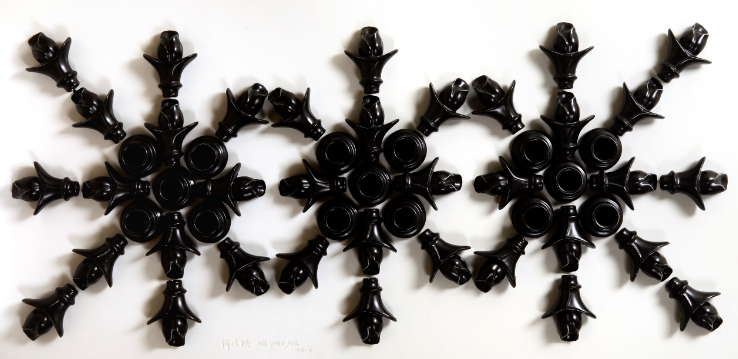
从具象到抽象,从绘画到装置,从上世纪九十年代到如今,何汶玦艺术创作的语言历经了多次变换与重组。在其艺术作品的创作母题中,权力、情欲、死亡常常以各种形态存在着——茫然一片的湖水、荧屏人物模糊的躯体,变幻莫测的城市之光,如梦幻和泡影一般的陶瓷釉面……
From the figurative to abstraction, from painting to installation, from the 1990s to the present, He Wenjue’s artistic language has undergone various transformation and reconfigurations. In his primary subject, power, lust and death exist in various forms –an overwhelming lake where ambiguous figures often seen on television are placed in front of it, and the dazzling city light, ceramic glaze are like dreams and bubbles…
I. 无处不在 Ubiquity
何汶玦对于权力的描述,在绘画上最为重要的一次表现是其2010-2011年创作的巨幅油画《盛世晚宴》,在这一幅作品中他将权力描述为资本追逐者、财富盘踞者之间的游戏,那些当代中国人们耳熟能详的企业家们,按照“最后的晚餐”的列座格局被安置进了画面,这些人都身处在同一阶层,资本实力相当,画面中没有出现这个阶层以外的人物,即便是中间的那位蒙面的“上帝”看起来也拥有某种高度的身份和地位(就算他可能是伪装的,也表现地像极了)。企业家之间的资本游戏被艺术家视为权力机制运作的新一轮角逐,权力与资本的抽象概念被渗透到了其艺术创作当中。在现代社会面前,权力和资本竞争面前,许多人选择规避,但现实是,资本全球化的时代,我们早已避无可避。
He Wenjue’s depiction of power is mainly shown in his painting Supper in Great Times in large dimensions done between 2010-2011. In this work, he depicts power as the game between the runners for capital and occupier of wealth. Those familiar Chinese entrepreneurs are placed in the painting based on the motif of the Last Supper. All of them are in the same social class with respectable capital power, no one outside of this class appeared on this image, even the central figure whose face is covered seem to hold a respectable identity and high position (even though it may be pretenses, his acting is superb). The artist considers the game of capital as a competition in operating the system of power. The abstract concept of power and capital is permeated into his artistic practice. In the contemporary society today, confronted with the competition of power and capital, many people have chosen to avoid it, but the reality is, in the globalized era, we can no longer hide.

何汶玦 He Wenjue, 《盛世晚宴》 Supper in Great Times , 布面油画 Oil on canvas, 75.5x240cm, 2010 (草稿sketch)
哲学家吉尔·德勒兹曾把权力比喻为一只鼹鼠,它的洞穴与网络布满了社会的角落,以各种形式弥散于众人之中,他指出现代社会中不存在一方占据着权力,而另一方就只是纯粹被动受难的情况,权力双方必然是一种相互依存,既可以自上而下,也可以自下而上。这样的一种维稳的关系在艺术作品中,最容易让人联想到的是建筑。
The philosopher Gilles Deleuze have made the analogy of power to a mole, his holes and networks are spread out into all corners of society, dispersed among people through various forms. He points out that the scenario of only one party who holds the power in its hand, and the others are in the suffering position does not exist in contemporary society, both parties of a power relationship rely on each other, that can go both ways, rising or falling. Such maintenance of stability in the creative industry makes one think of architecture.
何汶玦对世界各地标志性建筑的艺术再现源于2013年,他创作了一系列描绘世界各地景观的油画,画面中具有标志性和典型性的建筑层出不穷。英国建筑评论家迪耶·萨迪奇的曾论述,建筑是一种权力的雄辩术,它构成了城市的风景,永恒地诉说着权力,是个人或者国家宣扬身份的利器,是有雄心者向世界宣扬自己的工具,是权力和财富的表达,是创造和记载历史的方式。过去何汶玦将其自身的权力机制依托于主题性的绘画创作,彰显自身,表征自身,而在他最近创作的装置作品《长城》中,绘画上的表达方式被延续了下来,他分解了长城的建筑语言,将建筑与权力的关系用一块块金砖象征性的呈现了出来,并将它们置于不同的空间,相较于绘画中大手笔描绘这样一种形式更加凝练和冷静,在意图的表达上也更加直白明晰。
He Wenjue’s representation of landmark architectures throughout the world began in 2013, he created a series of sketches on worldly sceneries, consisting of remarkable and classical buildings. The British architecture critic Deyan Sudjic once commentedthat architecture is an eloquence of power, it constitutes as part of the urban landscape that dictates power eternally, it is a tool for an individual or a nation to manifest its identity, an expression of power and wealth, a way of creating and recording history. In the past, He Wenjue entrusts his own system of power on subjects of his paintings in order to reveal and symbolize the self, and in his recent installation, The Great Wall, the mode of expression adopted in his paintings are extended to this medium, he deconstructs the architectural language of the Great Wall and uses pieces of golden brick as the metaphor for power, and placing them into various spaces. Comparing to the sweeping brushstrokes, this method seems more condensed and rational, and the forthrightly expresses his goal.
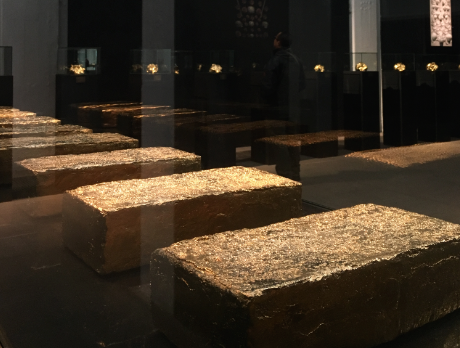
何汶玦 He Wenjue, 《长城》 Great Wall,局部
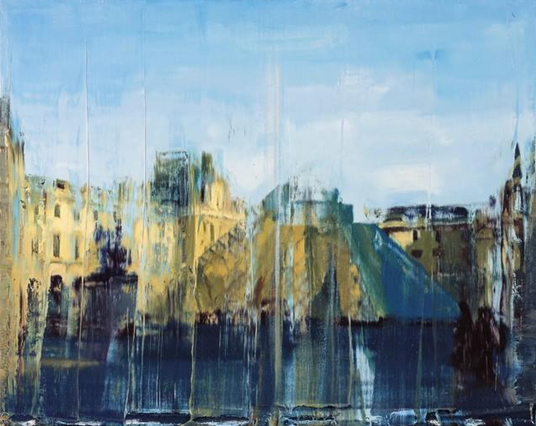
何汶玦 He Wenjue, 《日常影像-玻璃金字塔》 Daily Images-Glass Pyramid, 布面油画oil on canvas, 100cmx80cm, 2013
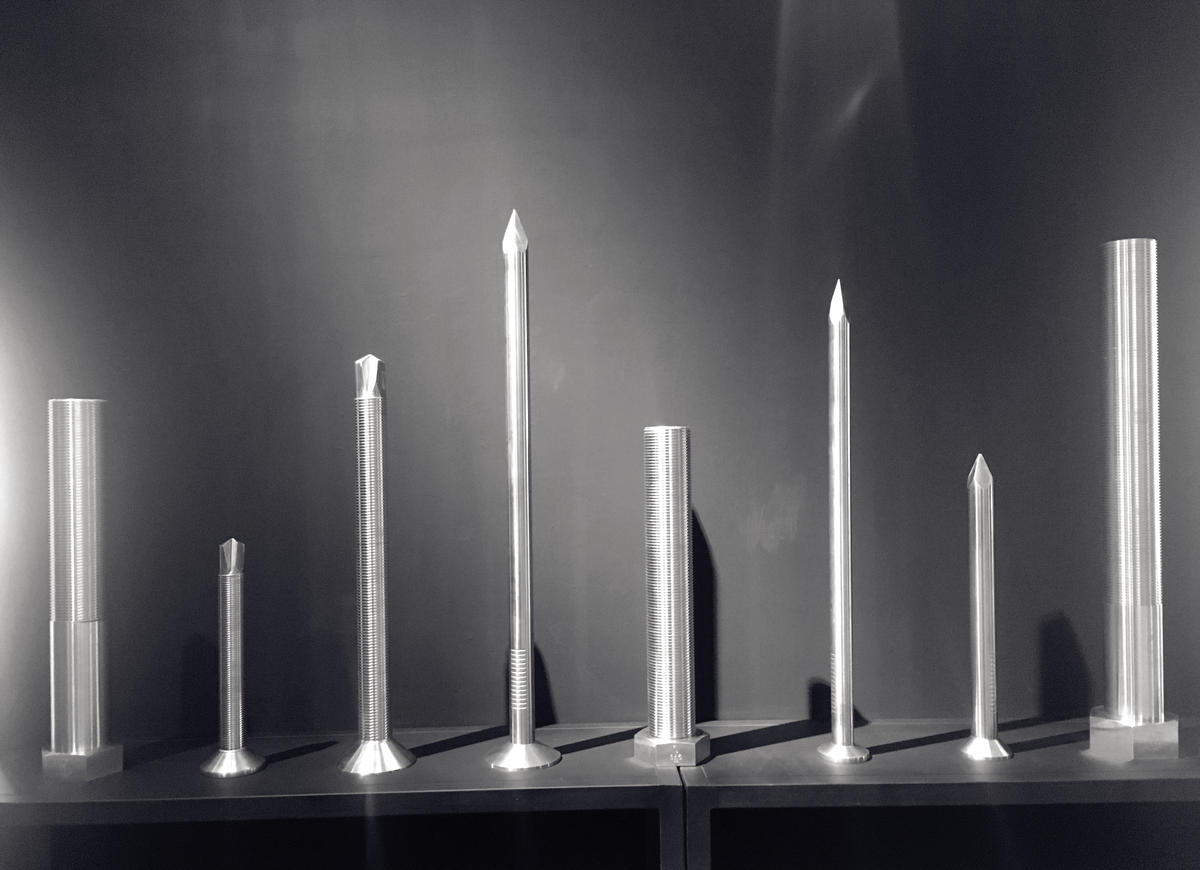
何汶玦 He Wenjue, 《权力、情欲、死亡》 Power Lust Death, 不锈钢 Stainless Steel, 尺寸不一 Variable Size,2006-2009
II. 送给死者的鲜花 Flower to the Dead
使用黄金作为主要材料的装置作品何汶玦还有很多,它们常常被置于凝重的氛围中,产生强烈的压迫感和控制感,令人感到沉重并且庄严。但在这部分作品之外,同期的装置作品中还有另外一种材料的使用减轻了这一份压抑,这个材料便是陶瓷。
Many of He Wenjue’s works use gold as his primary material in making installations, they are often placed in a solemn atmosphere, creating a strong sense of oppression and control, makes one feels solemn and monumental. Besides this series, the use of another material of the same period reduces such sense of oppression, which is ceramics.
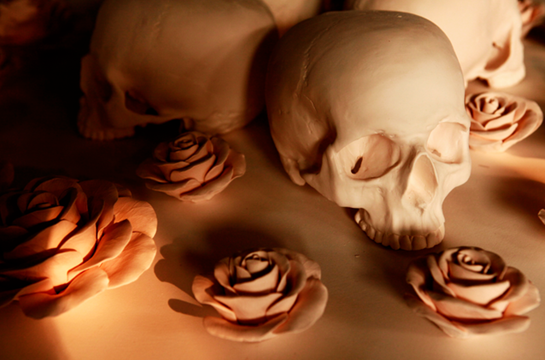
何汶玦 He Wenjue, 《蓝》Blue, (泥胎局部 clay idol details)
有俩个意象在何汶玦的陶瓷作品中出现的极为频繁——鲜花和头骨,运用这俩个意象表达死亡和情欲的艺术作品有许多,譬如典型的“虚空派 (vanitas)”绘画中,画家往往会将骷髅视为画面的重心或者主体,再加以鲜花、沙漏、乐器等,他们用骷髅即代表生命和死亡,鲜花等物即代表尘世生活所遗留的痕迹,这类绘画并不会让人觉得寓意浅显,或者过分沉重,它们只是在诉说生命的短暂和死亡的必然,嗟叹尘世中欢愉。何汶玦使用了一种新的语言突出了这种虚空——重复,他反复强调鲜花和头骨的凝固感及永恒性,将它们极具节奏性排列出来,不断地、重复地使用,从一个重复到另一个更深刻的重复。
There are two icons occur frequently in He Wenjue’s works - the flower and the skull. Using them to express death and lust in works of art is common, for instance, the classic “Vanitas” paintings, the painting would often consider the skull as the central or main object of the painting, with the addition of flowers, sand glass, musical instruments and etc, they have used skull to symbolize life and death, at the same time, the flowers are metaphors for the traces left behind by the mundane life. this type of painting does not make one think of its shallow metaphorical meaning, or being a heavy subject, but the ultimate inevitability of death and the shortness of life, lamenting on the joy and happiness of the worldliness. He Wenjue used a new language to highlight such emptiness – repetition. He emphasizes repetitively on the solidity and eternity of flower and skulls, and installing them rhythmically, and use them continuously and repetitively, from one repetition to a deeper repetition.
注:“Vnitas”拉丁语,意为空虚、松散、无意义的尘世生活和转瞬即逝的虚荣。圣经《传道书》在1:2章节中经常引用这个词语——虚空的虚空。凡事都是虚空(vanity of vanities; all is vanity)。在詹姆斯国王组织编纂的圣经版本中,该词被翻译为虚无中的虚无,彻底的无意义。新国际版本圣经中,该词被解释为一切都无意义。
Note: “Vanitas”, latin, implies emptiness, disorderly, meaningless mundane life and fleeting vanity. In the Bible, Ecclesiastes 1:2, uses the term vanity of vanities; all is vanity. In the King James Version of the Bible, this term is translated as the emptiness of vanity, complete meaninglessness. And in the New International Version of the Bible, the term is translated into everything is meaningless.
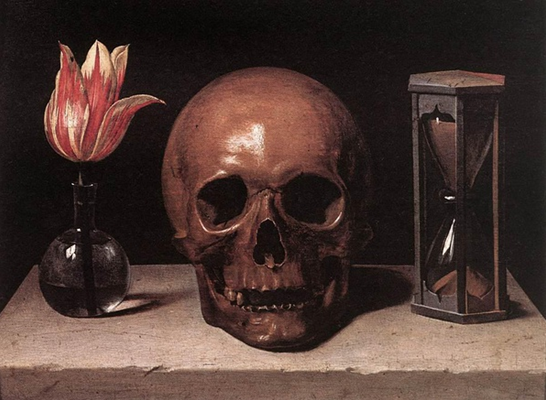
有头骨的静物 Still-Life with a Skull, 菲利普·德·尚帕涅 Philippe de Champaigne (1602-1674)
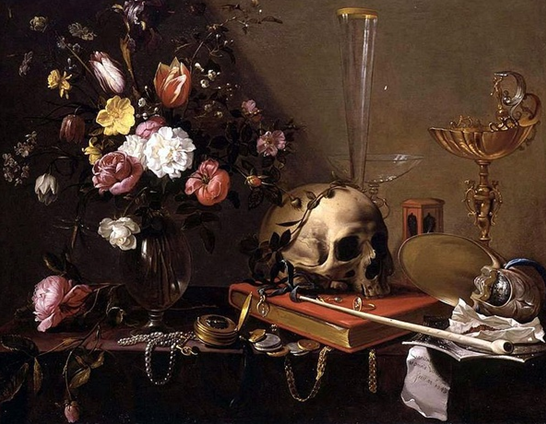
有花束和头骨的静物,Still Life with Bouquet and Skull, 阿德里安·凡·乌特勒支Adriaen van Utrecht (1599–1652)

何汶玦 He Wenjue, 《欲望之死》 Lust for Death, 瓷 Ceramic,220cmx100cmx12cm,2014-2015;
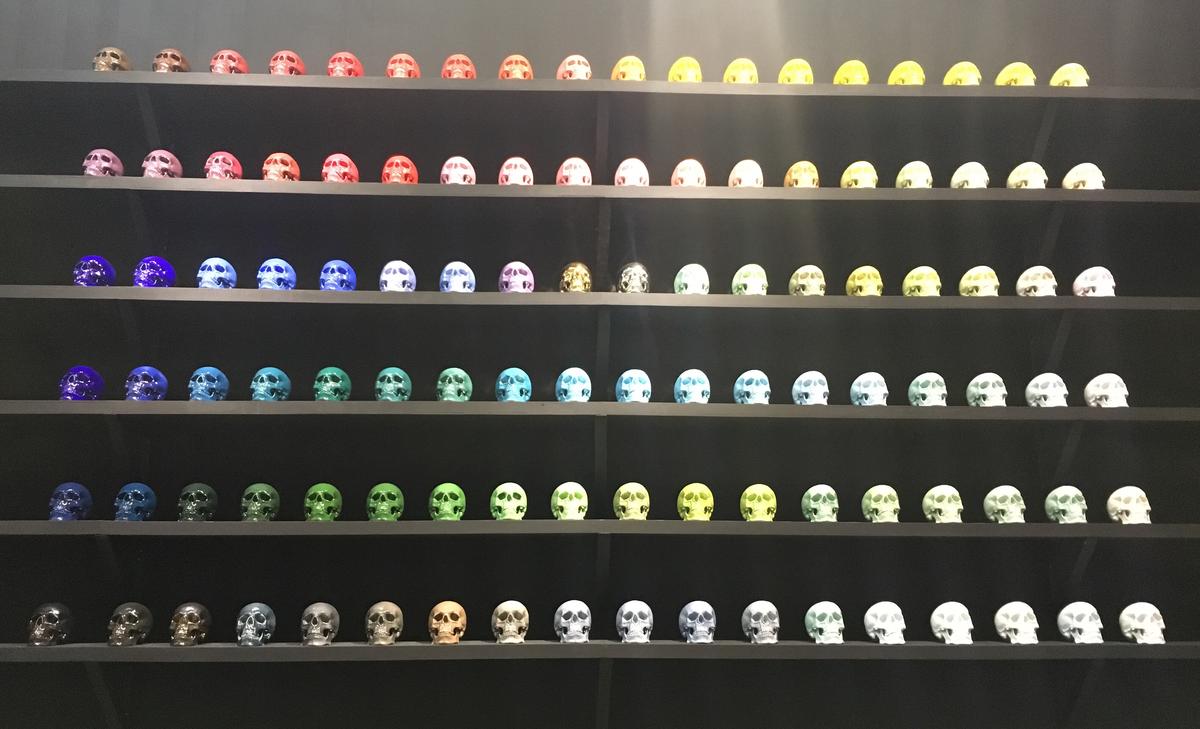
何汶玦 He Wenjue,《美丽人生》 Beautiful Life, 瓷 Ceramic, 23x16x16cm x 108, 2013-2015
III. 肉体毁灭 Destruction of the Physical Body
人们常常会用“洪流”一词来形容欲望的形态,并以“倾泻”、“流出”等词来描述欲望外化的方式,所有这些词都与“水”密不可分,倘若用“水”这一符号作为何汶玦作品中权欲与情欲的线索,不难发现,他实际在二十年前就已经进入了如今的创作母题,并且一直持续到了今天。
People often use the term “flood” to symbolize lust, and use “outpouring” or “flowing” to describe the outlet of desires, all of these terms are closely tied to water, if “water” is used as the metaphor to desire power and lust in He Wenjue’s works, then it is not difficult to discover that he has in fact entered his main subject twenty years ago, and have continued on this path until today.

何汶玦He Wenjue, 《水·2006 NO.1》 Water-2006, No.1, 布面油画 oil on canvas, 400cm×250cm, 2006
何汶玦绘画作品中的“人”经历了膨胀、弱化、隐退的过程后,如今以各类骨骼的形式再次出现,虽然肉体毁灭了,但这并未被艺术家视作生命的终结。他重塑了死亡,用具有社会性意义的材料(青铜、黄金、陶瓷、汉白玉等)替换了生物学意义的肉身,将人们割裂开来的生与死重新连接,使原本对立的生与死可逆甚至可控,通过这种方式让生命获得更多的时间。
甚至是,永恒——
The “figure” in He Wenjue’s paintings has experienced inflation, weakening, seclusion, and today the various forms of skeletons appear. Although the physical body has decayed, yet the artist hasn’t considered it as the end of life. He reconfigures death, and uses materials with social implications (bronze, gold, ceramics, white marble and etc.) to replace the physical body on a biological level, and reconnects life and death that have been separated in people’s minds, allowing the contrasting life and death to be reversible or even controllable. Through this approach, allowing more time gained in life.
Or even, eternally.
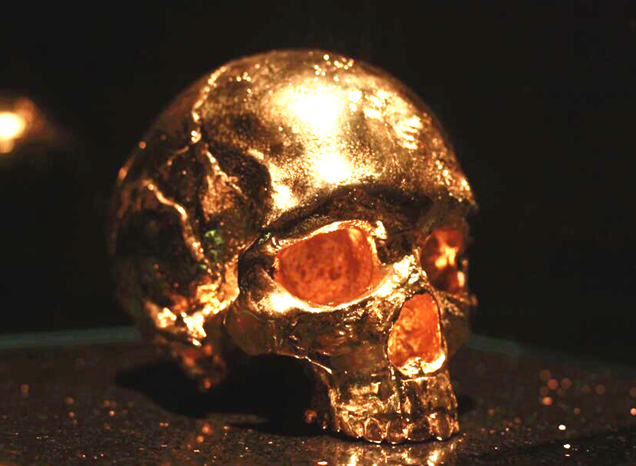
何汶玦 He Wenjue, 《永恒》 Eternity,青铜、24K黄金 Bronze、24K Gold,20 x 18 x 19cm,2007-2013;
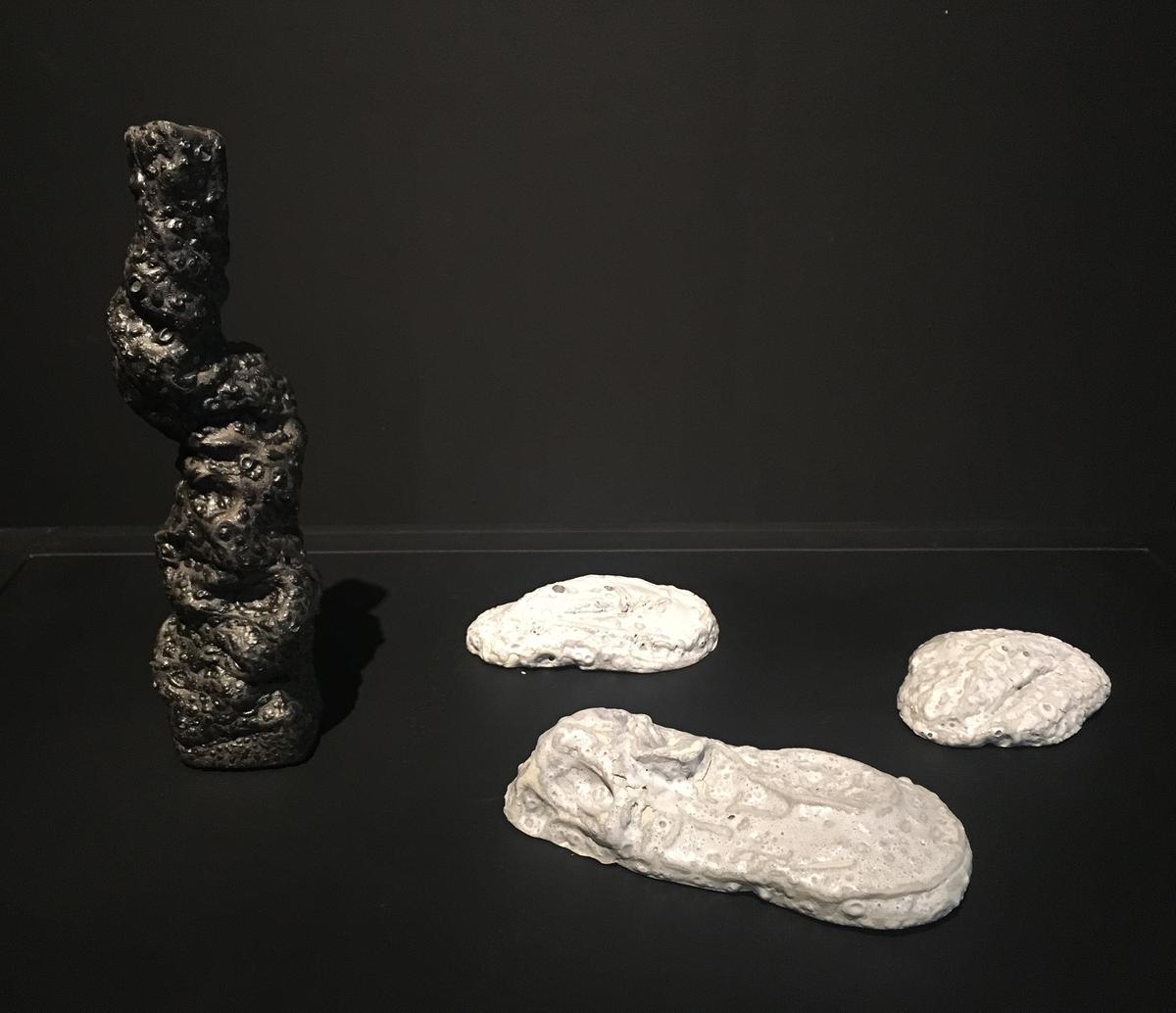 何汶玦 He Wenjue,《四喜》 Four Blessing, 瓷 Ceramic, 尺寸不一 Variable Size, 2014-2015
何汶玦 He Wenjue,《四喜》 Four Blessing, 瓷 Ceramic, 尺寸不一 Variable Size, 2014-2015
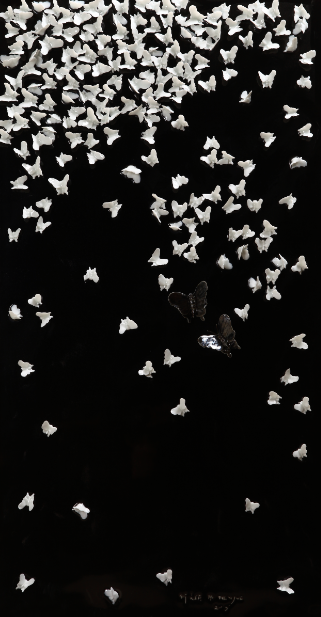
何汶玦 He Wenjue, 《梁山伯与祝英台》 Butterfly Lovers, 瓷 Ceramic, 110x57x5cm, 2014-2015
———————————————————
2015.12
王芹
By Wang Qin